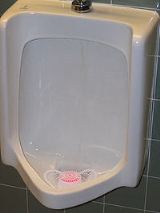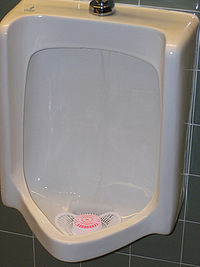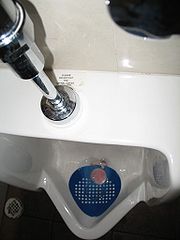
Urinal deodorizer block
Encyclopedia


The purpose of these blocks is to disinfect and deodorize restroom urinals, placed above the urinal drain (often in the confines of a small plastic trap known as a "Puck Caddy" that prevents their loss down the drain when they dissolve to a small size).
Appearance and composition
These are usually cylindrical tablets used to prevent bad odors in washrooms. The chemicals composing the block may vary. The original formulations were of naphthaleneNaphthalene
Naphthalene is an organic compound with formula . It is a white crystalline solid with a characteristic odor that is detectable at concentrations as low as 0.08 ppm by mass. As an aromatic hydrocarbon, naphthalene's structure consists of a fused pair of benzene rings...
and later paradichlorobenzine
1,4-Dichlorobenzene
1,4-Dichlorobenzene is an organic compound with the formula C6H4Cl2. This colorless solid has a strong odor. It consists of two chlorine atoms substituted at opposing sites on a benzene ring. p-DCB is used a pesticide and a deodorant, most familiarly in mothballs in which it is a replacement for...
(pDCB), both now known to be hazardous to health by inhalation. Most urinal blocks are now paradichlorobenzene-free.
The block's functionality is enhanced by saturating it with a scenting compound and quaternary ammonium compounds.
They come in a variety of shapes and sizes, and weigh from about 20 grams up to about 100 grams when new.
Paradichlorobenzene and naphthalene blocks do not actually dissolve in water or urine, but only sublimate into the air, creating an odor that masks the smell of urine. Urinal-deodorizer companies now produce water-soluble versions made from surfactant
Surfactant
Surfactants are compounds that lower the surface tension of a liquid, the interfacial tension between two liquids, or that between a liquid and a solid...
s, which offer some active cleaning efficacy. The new water-soluble blocks improve the cleaning of the pipes to remove some of the cause of odor problems. Some recent formulations also include bacterial strains which, coupled with the surfactant cleaning power, can completely eradicate odors and blockages caused by the buildup of solids in the traps
Trap (plumbing)
In plumbing, a trap is a U-, S-, or J-shaped pipe located below or within a plumbing fixture. An S-shaped trap is also known as the S-bend invented by Alexander Cummings in 1775 but became known as the U-bend following the introduction of the U-shaped trap by Thomas Crapper in 1880. The new U-bend...
and pipes.
Some manufacturers claim that these "biological blocks" can enable completely no-flush waterless urinals to be fitted.

